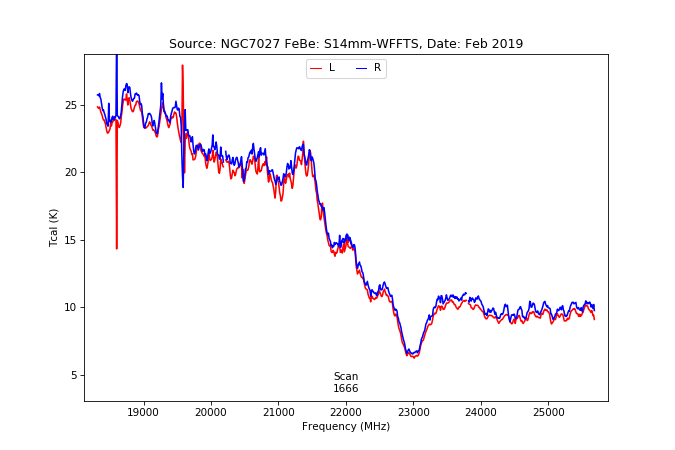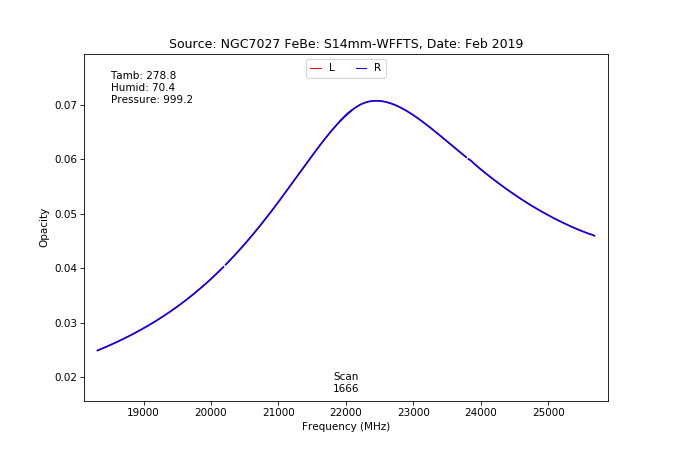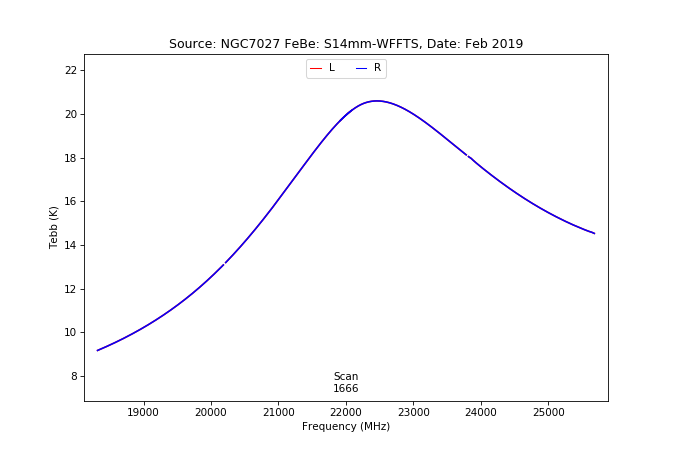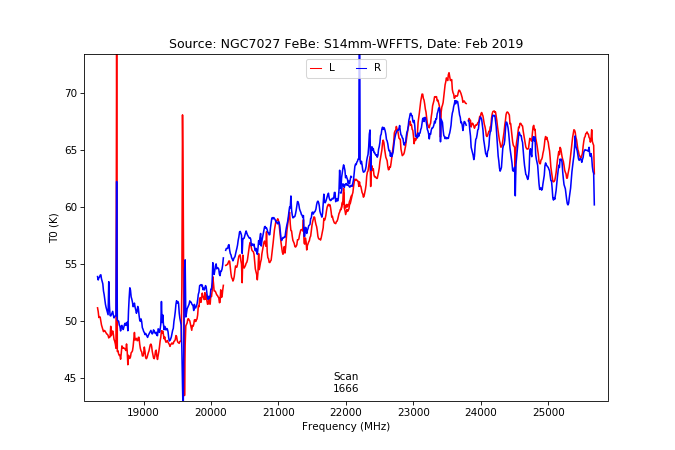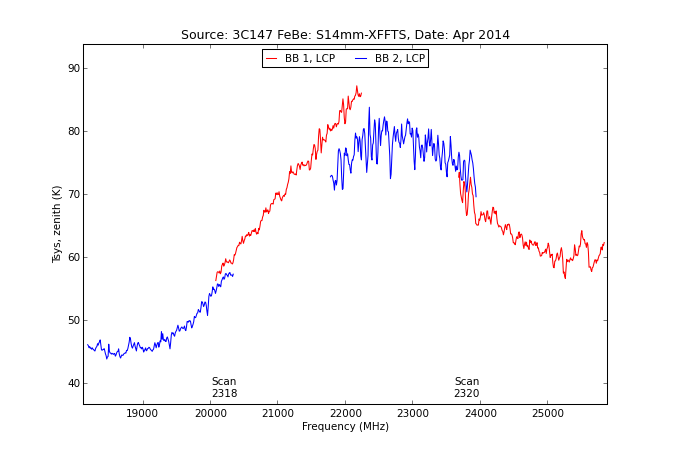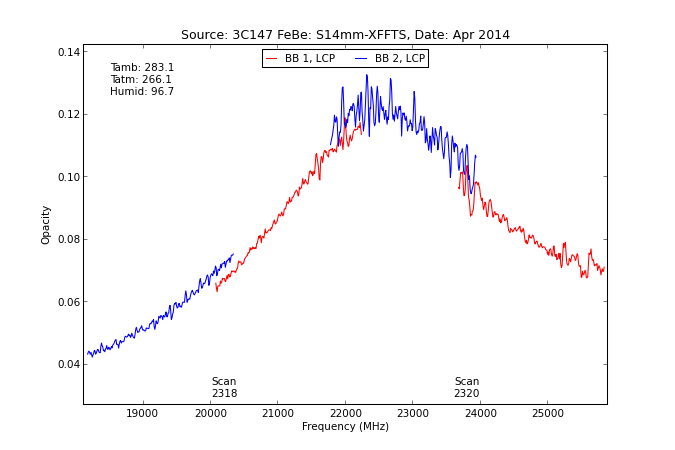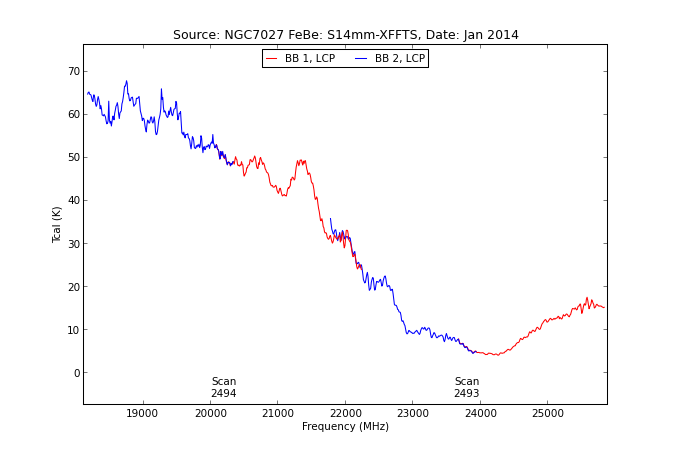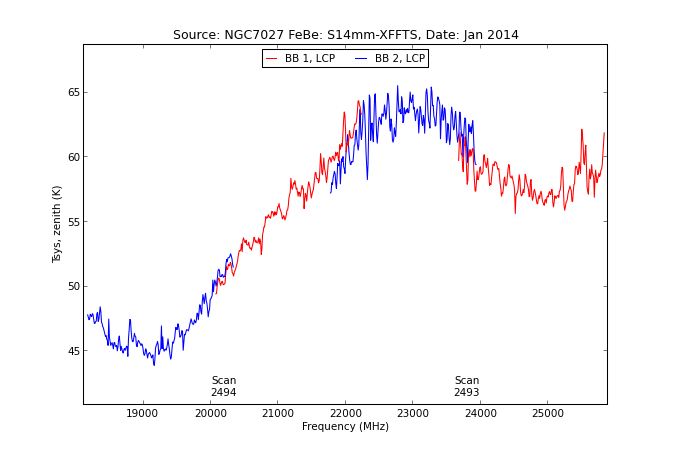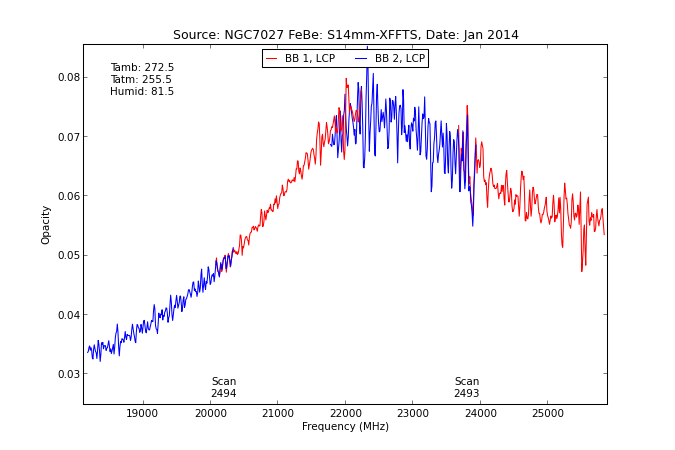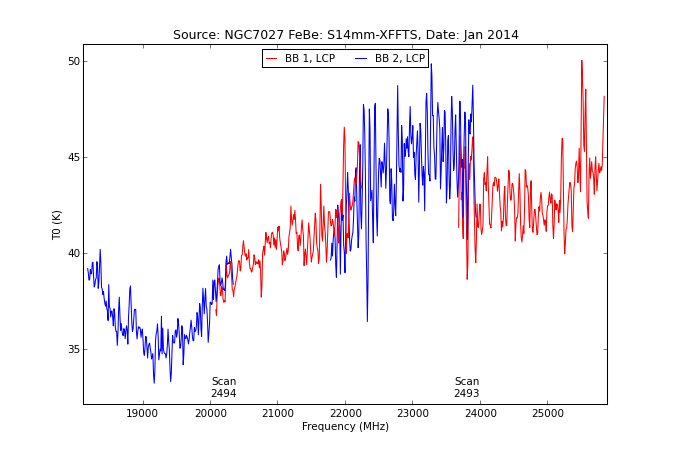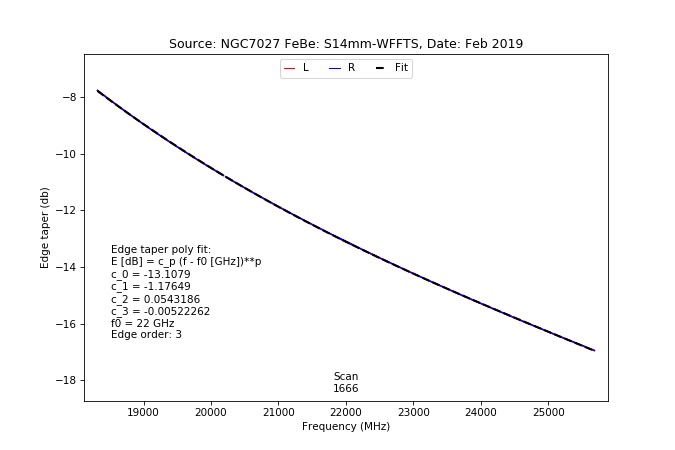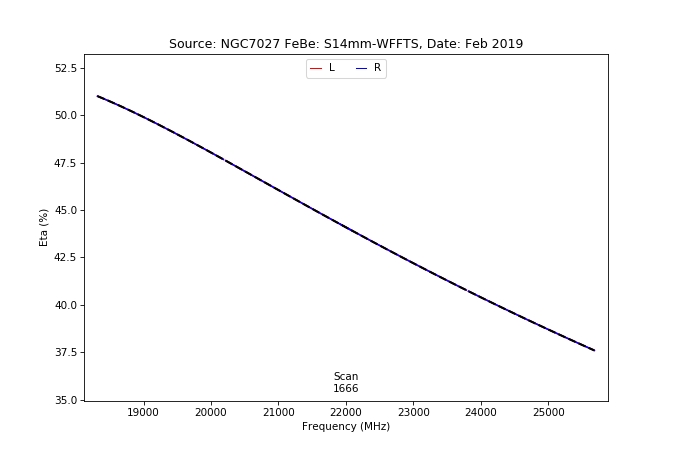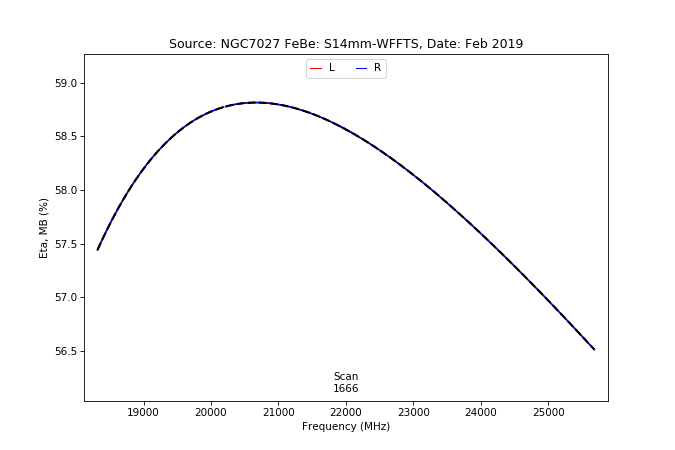Table of Contents
1.3cm double beam secondary focus receiver (18000-26000 MHz)
This is a two horn system especially for continuum, spectroscopy and VLBI observations.
Overview
| RX Name | Band | Frequency range [GHz] | Polarisation | Nr. of Horns | Horn position relativ to center of focus cabin |
|---|---|---|---|---|---|
| S14mm | K | 18.0-26.0 | dual-circular | 2 | Horn 1: Az: -95.6 arcsec, Elv: 734.2 arcsec, Horn 2: Az: 95.6 arcsec, Elv: 734.2 arcsec |
Calibration Information
| Frequency [GHz] | Channel | Polarisation | Tcal [K] | Tsys [K] | Sensitivity [K/Jy] | SEFD [Jy] | Aperture Eff. [%] | TMB/S [K/Jy] | Main Beam Eff. [%] | FWHM [arcsec] | Last update |
|---|---|---|---|---|---|---|---|---|---|---|---|
| 19.25 | 1/2 | LCP/RCP | 13.1 | 47 | 1.09 | 43 | 38 | 1.56 | 67 | 40.4 | Jul 2024 |
| 21.15 | 1/2 | LCP/RCP | 9.2 | 67 | 1.05 | 64 | 37 | 1.74 | 61 | 37.8 | Jul 2024 |
| 22.85 | 1/2 | LCP/RCP | 9.0 | 74 | 1.03 | 72 | 36 | 1.41 | 79 | 36.8 | Jul 2024 |
| 24.75 | 1/2 | LCP/RCP | 8.0 | 72 | 1.01 | 71 | 36 | 1.57 | 71 | 34.5 | Jul 2024 |
| 22.25 | 1/2 | LCP/RCP | 8.4 | 72 | 1.05 | 71 | 36 | 1.57 | 71 | 36.8 | Jul 2024 |
| 23.77 | 1/2 | LCP/RCP | 8.0 | 72 | 1.03 | 71 | 36 | 1.57 | 71 | 35.2 | Jul 2024 |
| normalized Gain curve (G = A0 + A1·Elv + A2·Elv2) | Observed in | confirmed | ||
|---|---|---|---|---|
| A0 = 0.981 | A1 = 1.08E-3 | A2 = -1.52E-5 | Jul 2024 | Jul 2024 |
Comments:
- Note that the system temperature at this frequency depends strongly on weather conditions!
- Zenith tau values can range from 0.05 to more than 0.2.
The receiver delivers the data by default in four 2.5GHz-wide IF-subbands:
| Band | Frequency Range |
|---|---|
| 4 | 18.0-20.5 GHz |
| 3 | 19.9-22.4 GHz |
| 2 | 21.6-24.1 GHz |
| 1 | 23.5-26.0 GHz |
Additionally, there are several receiver versions (see below) which allow to observe two 300 MHz-wide bands, e.g. for 22.25 GHz (i.e., the water line) and 23.77 GHz (NH3 (1,1)-(3,3)).
Available receiver versions (for OBSINP)
| Version | Description | Details |
|---|---|---|
| dualpix_dualpol_cont_OPTOCBE | standard continuum backend with 4 basebands | 4x 2.5 GHz |
| dualpix_dualpol_hires_h2o_nh3 | spectroscopic mode with two basebands, centered at 22.25 and 23.77 GHz | bandwidth is 300 MHz per baseband |
Below here: Information is currently updated.
Receiver Bands
Channel assignment in the MBFITS data files
Note that the narrow line and VLBA IF channels are usually only available when the specific line version of the receiver was selected. In addition for most receivers with narrow line channels the cables at the patch board need to be connected by the receiver group.
To select different channel numbers in OBSINP, the online plot, or the toolbox the numbers have to be specified like c(1)+c(2) to add channel 1 and 2. E.g. channel 1 and 2 contain the LCP and RCP broadband channels, then "OnlPlot pen='c(1)+c(2)'" or "toolbox use='c(1)+c(2)'" will select these channels. In OBSINP the pen can be directly specified in the receiver selection menu.
Abbreviations:
SB: narrow band channel (Schmalband-Kanal), 100 MHz band width
BB: digital broad band channel (Breitband-Kanal), band width varies for different receivers
VLBA: VLBA IF, 500 MHz band width
BW: band width
TP: total power
| 1.3cm SFK single horn receiver | |||
|---|---|---|---|
| Channel | IF | Pol. | Comment |
| 1 | BB | LCP | TP A |
| 2 | BB | RCP | TP B |
Spectroscopy modes and resolution
Low-res mode (4 basebands for each of 2 feeds and 2 polarizations)
Note, that due to technical reasons the LSR correction has to be applied via software (regridding). This will decrease the effective spectral resolution to some degree.
| BW | nchan | nu | Df | Dv | dv |
|---|---|---|---|---|---|
| MHz | MHz | kHz | km/s | km/s | |
| 2500 | 16384 | 18000 | 152.6 | 2.541 | 2.948 |
| 2500 | 16384 | 20000 | 152.6 | 2.287 | 2.653 |
| 2500 | 16384 | 22000 | 152.6 | 2.079 | 2.412 |
| 2500 | 16384 | 24000 | 152.6 | 1.906 | 2.211 |
| 2500 | 16384 | 26000 | 152.6 | 1.759 | 2.041 |
| 2500 | 32768 | 18000 | 76.3 | 1.271 | 1.474 |
| 2500 | 32768 | 20000 | 76.3 | 1.144 | 1.327 |
| 2500 | 32768 | 22000 | 76.3 | 1.040 | 1.206 |
| 2500 | 32768 | 24000 | 76.3 | 0.953 | 1.105 |
| 2500 | 32768 | 26000 | 76.3 | 0.880 | 1.020 |
| 2500 | 65536 | 18000 | 38.1 | 0.635 | 0.737 |
| 2500 | 65536 | 20000 | 38.1 | 0.572 | 0.663 |
| 2500 | 65536 | 22000 | 38.1 | 0.520 | 0.603 |
| 2500 | 65536 | 24000 | 38.1 | 0.477 | 0.553 |
| 2500 | 65536 | 26000 | 38.1 | 0.440 | 0.510 |
BW … band width
nchan … number of spectral channels
nu … center frequency
Df … Channel separation (in frequency)
Dv … Channel separation (in velocity)
dv … Velocity resolution (dv=1.16*Dv)
Hi-res mode (28 basebands for 1 feed and 1 polarization only)
| BW | nchan | nu | Df | Dv | dv |
|---|---|---|---|---|---|
| MHz | MHz | kHz | km/s | km/s | |
| 300 | 16384 | 18000 | 18.3 | 0.305 | 0.354 |
| 300 | 16384 | 20000 | 18.3 | 0.274 | 0.318 |
| 300 | 16384 | 22000 | 18.3 | 0.250 | 0.289 |
| 300 | 16384 | 24000 | 18.3 | 0.229 | 0.265 |
| 300 | 16384 | 26000 | 18.3 | 0.211 | 0.245 |
| 300 | 32768 | 18000 | 9.2 | 0.152 | 0.177 |
| 300 | 32768 | 20000 | 9.2 | 0.137 | 0.159 |
| 300 | 32768 | 22000 | 9.2 | 0.125 | 0.145 |
| 300 | 32768 | 24000 | 9.2 | 0.114 | 0.133 |
| 300 | 32768 | 26000 | 9.2 | 0.106 | 0.122 |
| 300 | 65536 | 18000 | 4.6 | 0.076 | 0.088 |
| 300 | 65536 | 20000 | 4.6 | 0.069 | 0.080 |
| 300 | 65536 | 22000 | 4.6 | 0.062 | 0.072 |
| 300 | 65536 | 24000 | 4.6 | 0.057 | 0.066 |
| 300 | 65536 | 26000 | 4.6 | 0.053 | 0.061 |
BW … band width
nchan … number of spectral channels
nu … center frequency
Df … Channel separation (in frequency)
Dv … Channel separation (in velocity)
dv … Velocity resolution (dv=1.16*Dv)
Tcal measurements
February 2019
Tcal and Tsys
Opacity and Tebb (WVR+AATM)
T0
April 2014
Note, that in April the Tcal was changed in the receiver. Gaps in the curves are entirely due to measurement uncertainties. T0 and Tsys were deduced from spectroscopic skydip measurements and are subject to fitting errors caused by the low signal-to-noise ratio in the spectral bins.
